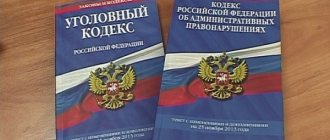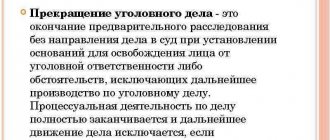New edition of Art. 153 Code of Criminal Procedure of the Russian Federation
1. Criminal cases in relation to:
1) several persons who have committed one or more crimes in complicity;
2) one person who has committed several crimes;
3) a person accused of concealing crimes that were not promised in advance and are being investigated in these criminal cases.
2. The connection of criminal cases is also permitted in cases where the person to be charged as an accused has not been identified, but there are sufficient grounds to believe that several crimes were committed by one person or group of persons.
3. The connection of criminal cases being processed by the investigator is carried out on the basis of a resolution of the head of the investigative body. The combination of criminal cases under investigation by the investigator is carried out on the basis of a decision of the prosecutor. The decision to combine criminal cases of crimes investigated in accordance with Articles 150 and 151 of this Code by different preliminary investigation bodies is made by the head of the investigative body based on the decision of the prosecutor to determine jurisdiction. If the preliminary investigation is carried out in the form of an inquiry, the said decision is made by the prosecutor.
4. When combining criminal cases, the period for proceedings on them is determined by the criminal case that has the longest period of preliminary investigation. At the same time, the period of proceedings in other criminal cases is absorbed by the longest period and is not additionally taken into account.
Investigative and judicial practices under Article 153 of the Code of Criminal Procedure of the Russian Federation
Merging examples:
- Lawyer D.S., head of A.K., an officially unregistered organization “Christian State”, announced the merger of his client’s two cases and their transfer to the Investigative Committee. The leader of this organization was arrested in September for putting pressure on public institutions for showing the film Matilda. He is accused of sending letters to cinemas demanding that they refuse to distribute the film. In October, a criminal case was opened on extremism against A.K. The cases were merged.
- The Presidium of the Stavropol Regional Court decided to merge two legal cases against the bandit group Sh.B., which committed bloody raids and terrorist attacks in Budennovsk, Pervomaisk, Beslan and other territories of the region since 1995, to consider them. They are charged with extremism, terrorism, and banditry.
- A legal case was sent to the court against the head of the bank M.U., its initiation began in February 2011. During the investigation, it was established that U. organized and led a criminal group, with the help of which he seized corporate control in many banking institutions in Moscow and regions of the Russian Federation, after which their assets were stolen; only an approximate amount was established, exceeding 15 billion rubles. In fact, investigators from all over the country have done a tremendous amount of work collecting criminal cases initiated on the facts of U. crimes for their connection on the basis of the Main Investigation Department at the Main Directorate of the Ministry of Internal Affairs of the city of Moscow. The measures taken in the investigative activities completely revealed the criminal acts of the accused of an economic crime. The work of the investigative body is to deeply study each case, prevent, prevent erroneous actions, so that the investigation does not deviate from the correct course.
Thanks to the consolidation of cases, the judicial authorities are able to fully and comprehensively consider violations and get to the bottom of the truth.
How does it help?
The merger occurs in one proceeding in which one person with the status of:
- person under investigation;
- the accused;
- the defendant.
For those who have committed several offenses, it helps the investigative and judicial authorities to fully assess the volume and characteristics of the criminal act and, as a rule, impose the proper punishment.
The representative conducting the preparatory investigation establishes:
- The psychological makeup of the personality of the suspect or accused.
- Criminal connection, patrons or people who are accomplices.
- A more suitable condition is created for exploring the offender's environment.
These circumstances help to effectively investigate offenses committed by a suspected citizen against whom charges have been brought.
If we specifically touch upon the procedure for merging legal cases, it should be noted that the Code of Criminal Procedure of the Russian Federation does not specify the procedural procedure for merging in sufficient detail.
The legislation does not specify the required procedure for this action, so procedural errors occur.
Another comment on Art. 153 Criminal Procedure Code of the Russian Federation
1. The presence of the circumstances listed in paragraphs 1 - 3 of part 1 of the commented article does not necessarily entail the connection of criminal cases. The decision on such a connection is made taking into account the expediency from the point of view of comprehensiveness, completeness and objectivity of the preliminary investigation. If there is no expediency, criminal cases may be investigated and tried in court separately, separately.
2. If among the cases to be joined there are suspended or terminated cases, they can be joined only after the resumption of proceedings on them in the prescribed manner. The above applies, in particular, to the cases provided for in Part 2 of the commented article, when cases of unsolved crimes are joined, the proceedings for which have been suspended due to the failure to identify the person to be charged as an accused.
Legal commentary
As amended by the commentary to Art. 153 of the Code of Criminal Procedure indicates the following theses:
- Combination is carried out if a person appears as an accused in one case, and as a victim in another.
- Consolidation of criminal cases under the Code of Criminal Procedure of the Russian Federation is an optional action. This is not news, but a established pattern; the totality of the circumstances of each individual case, the importance of objective, timely action in the investigation are taken into account. Preliminary inquiry and criminal proceedings determine the need for combination. This concentrates the power and methods of analyzing investigations to the investigative body as much as possible. The detailed aspects of the legal violations committed or one violation committed in connection are also fully determined. Research into existing evidence is carried out efficiently, which ultimately saves time, effort and money.
- To base the connection, accomplices, victims, witnesses, defendants, civil plaintiffs or other involved citizens are not taken into account when their actions are disparate and relate to different legal violating actions, there are no signs of their involvement.
- Grouping legal cases into a single one is possible by the leadership of the investigative body after it issues the appropriate form of the decision. When legal cases are under the jurisdiction of several investigative bodies, the prosecutor leading the combined cases decides on their merger. Initiation of the combination is possible by the body of inquiry and the head of the investigation, since he directs and controls the progress of the investigation.
- The prosecutor issues permission to consolidate legal cases pending with the investigator.
- For connected cases, the production deadlines change; the longest of the preliminary investigations is selected. The smallest ones are absorbed for the longest period of time, then those that do not appear anywhere. A separate procedural document in this regard is not required.
To connect cases, it is necessary to prove the involvement of persons in the offenses committed. Only after the accusation can a combination be made.
But the edition of the commentary to the code also states that there is a law of exclusion that allows their association in relation to a suspect or unidentified persons.
The basis for combining cases is the involvement of different people in one violation, the connection of various actions with the same people.
The following commentary to Article 154 of the Code of Criminal Procedure of the Russian Federation
If you have questions regarding Art. 154 of the Code of Criminal Procedure, you can get legal advice.
1. The general rule for separating a new criminal case from one investigative proceeding is based on the fact that there is no connection between the crimes under investigation committed by different persons (clause 3 of part 1 of the commented article). Along with it, there is also a special rule, according to which a case is singled out, the proceedings on which are subject to suspension (clause 1, part 1 of the commented article), or a case on charges of a minor accused of a crime committed by a group of adults (clause 2, part 1). 1 commented article). The meaning of these special rules is that a suspended case, if not allocated, cannot be sent to court, and proceedings in cases of minors have features established by law.
2. If at the stage of the preliminary investigation against one of those accused of committing a crime by prior conspiracy, the case was separated into separate proceedings in connection with his search, and by the time the court considered the case against the second accomplice, the fugitive was detained and the separate consideration of these cases could affect on the comprehensiveness of the investigation, it is subject to referral for a preliminary investigation due to the need to combine two cases in one proceeding <1>.
——————————– <1> BVS. 1998. N 6.
3. The case may be separated if the material cannot be combined in one proceeding due to the mental or other serious illness of one of the accused, which is confirmed by properly executed documents. If one of the accused fled, the court suspends the case against him until the search, separating him into separate proceedings, and continues the proceedings against the remaining defendants. In cases where separate proceedings would make it difficult to establish the truth, all proceedings in the case are suspended. The court must give reasons for such a decision <1>.
——————————– <1> BVS. 1998. N 4. P. 19.
4. Cancellation of a sentence against one of the defendants based on the unjustified allocation of a case against the second defendant to special proceedings can only take place if the actions incriminated against the second defendant are in close connection with the actions of the first and separate consideration of the cases may affect the correctness sentence against both defendants or one of them.
5. According to part 3 of the commented article, if a criminal case is separated into separate proceedings for the purpose of conducting a preliminary investigation of a new crime or against a new person, the resolution on the separation of the criminal case must also contain a decision to initiate a criminal case. This provision is controversial, and the need for such a rule is doubtful. Separating a case is simply dividing one case into two.
Commentary on Article 153 of the Code of Criminal Procedure of the Russian Federation
1. The connection of criminal cases as a general condition of the preliminary investigation ensures its comprehensiveness, objectivity and completeness. For these purposes, the investigative body combines two or more criminal cases in one proceeding if there are grounds specified in the commented article.
2. Comprehensiveness, objectivity and completeness of the investigation should not conflict with other principles of the criminal process. Thus, the exercise of the accused’s right to defense is possible only against an individual, specific accusation. An endless investigation into the accused’s “dark past” would practically deprive him of this procedural right. An excessive requirement to disclose all crimes committed by all persons is contrary to the right to be tried without undue delay (clause “c” of Part 3 of Article 14 of the Covenant on Civil and Political Rights). Unreasonably combining cases is fraught with the risk of turning the proceedings into a multi-volume paper “monster”, delaying the process and violating the deadlines for the investigation, trial, and detention. For this reason, unlike the Code of Criminal Procedure of the RSFSR of 1960, in the current Code, the connection of cases no longer enjoys clear priority over their separation. However, the Code of Criminal Procedure as amended. The Federal Law of July 4, 2003 granted the judge the right to return the case to the prosecutor if there are grounds for joining the cases (clause 4, part 1, article 237). As a result, this norm has become, in a sense, a sanction for not joining cases during the preliminary investigation.
3. As a rule, to connect cases, it is necessary to prove the participation of persons in the commission of crimes. Therefore, the cases are joined against the accused (after a decision has been made to charge them as an accused). As an exception, the law does not prohibit joining cases against suspects and even against unidentified persons. At the same time, it should be noted that due to the presumption of innocence, the accused is considered innocent of committing a crime until the court verdict enters into legal force. Therefore, when connecting cases, it is unlawful, in our opinion, to talk about the commission of crimes by the accused, and especially by the suspects, as is done in Part 1 of the commented article. Its provisions should be interpreted restrictively, for example, to speak not about the commission of several crimes by one person (clause 2 of part 1 of the article), but about the fact that a person has the procedural status of an accused or suspect in several criminal cases, etc. Part 2 of the commented article gives the right to join cases against unidentified persons if there is evidence that crimes were committed by the same person or the same group. This may be evidence about a specific method of committing a crime, the subject of the crime (for example, belonging to one batch of counterfeit money).
A special type of connection of cases is the combination in one proceeding of counter-statements in a private prosecution case (Part 3 of Article 321 of the Code of Criminal Procedure).
It is not allowed to join cases on other grounds (commonality of criminal results of careless acts of non-participants; careless storage of a weapon and its use by another person).
4. The condition for connection is the presence of the cases themselves that have been initiated and under investigation, since only criminal cases, but not materials, can be combined in one proceeding. The following rules follow from this condition: a) cases suspended and terminated cannot be combined without correspondingly resuming the case or canceling the decision to terminate the case; b) if during the investigation a new crime is discovered (event, fact for which the case was not initially initiated), then it is necessary first in accordance with Art. 146 of the Code of Criminal Procedure, make a decision to initiate a new case, and then combine them in one proceeding. For more information, see com. to Art. 146.







